【Watch Massage With My Husband Online】
How to Read a Squiggle
Arts & Culture
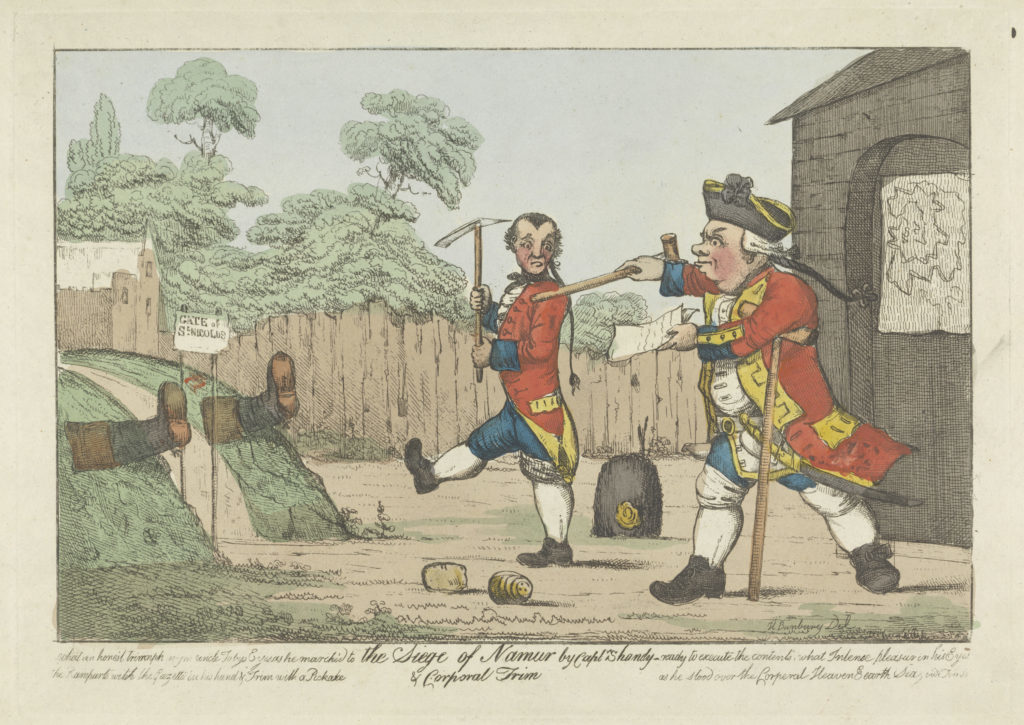
William Henry Bunbury’s print The Siege of Namur, published in The Life and Opinions of Tristram Shandy, Gentleman, by Laurence Stern.
Text is composed of lines both literal—the ink on the page—and conceptual—the story line or plotline that, like thread unwinding from a spool, guides us through the turns of a narrative. When we depict someone reading, we tend to signify text with a continuous wiggly line on the pages or the cover of a book. This kind of squiggle, hovering somewhere between text and image, conveys the singular shape of a narrative text. It’s a figure for the act of reading.
One of the most recognizable literary lines of the eighteenth century is precisely such a squiggle. It occurs in the ninth chapter of the fourth volume of Laurence Sterne’s Tristram Shandy, during a conversation between Tristram’s Uncle Toby and his faithful manservant, Corporal Trim, about bachelorhood and celibacy. The corporal, a character usually prone to long, sentimental speeches, declares, “Whilst a man is free—,” and gives “a flourish with his stick thus—”
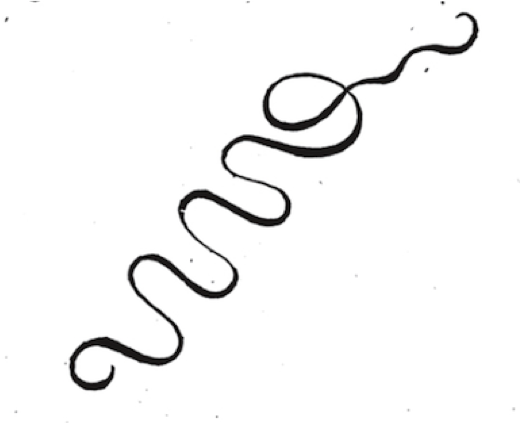
Sterne’s squiggle breaks through the text, slithering up the page like the words it replaces. It’s continuous with the text but is not, itself, textual. “A thousand of my father’s most subtle syllogisms,” reflects Shandy, “could not have said more for celibacy.” Translated into a typographic squiggle, the flourish makes a case for a wordless representation. It’s an argument for the unimpeded life of the bachelor or the dandy, free to move and turn however he pleases. It’s also a wry, playful critique of the self-presumed ability of words to represent in a straightforward or linear manner. Curiously enough, Shandy introduces Trim earlier in the novel by noting that “the only dark line” of his character is his propensity for interminable speechmaking: “he could not bear to stop his mouth.” Trim’s function in the plot, as the dispenser of rambling advice, might be to show how narrative can lapse into a meandering flourish.
Tristram Shandyis a digressive meditation on storytelling, an autobiography whose protagonist’s birth itself is delayed until its fourth volume. At one point, Shandy pauses to draw out the versions of the plotline articulated in its first five volumes, each one contorted by bumps, twists, and curls. Seen in these terms, the novel becomes a project in interrupting the conventional narrative line, complicating what he calls “the shortest line … which can be drawn from one end to another,” the simplest, straightest transfer from A to B, from beginning to end. Life, in this text, is endlessly, hilariously tangled.
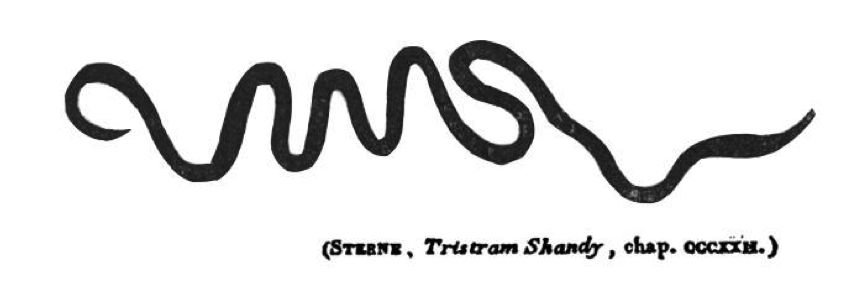
Given that Sterne’s squiggle makes trouble of realism, it’s striking that we should encounter it again seventy years later in a novel by Honoré de Balzac, one of the nineteenth century’s most prolific realists. That Balzac adopted Sterne’s squiggle as a visual epigraph to his 1831 novel, The Magic Skin, is well known (see Aaron Schuster’s 2009 essay on the subject); so, too, is his misattribution of the figure to a nonexistent chapter (chapter 322) of Tristram Shandy. Balzac’s line also suggests the transfiguration of life into writing. This novel, his only truly “fantastic” one, describes a pact in which its protagonist’s life is sacrificed. Raphäel de Valentin purchases a magic skin, which grants him his every wish but shortens his life in consequence, shrinking as it does so. The squiggle, once a representation of freedom, now begins to look like the tapering out of vital energies, like a life squandered in the name of desire. Balzac was well versed in the drawing out of lifelines, their correspondent knottings-together and untyings. The Human Comedy is a vast and impossible work of literature, claiming to represent French society in all its superficial constellations and deeper socioeconomic impulses through the lives of more than seven hundred characters. Its task was the documentation of life in uncountable spatial and typographical formulations—how it begins, continues, finishes, its endless reroutings.
Balzac rotated Sterne’s squiggle onto its side and unraveled its last curlicue—acts that speak, as critics have speculated, to Balzac’s explicitly “serpentine” conception of life. Certainly this reading was shared by a later publisher, Houssiaux, who coaxed the squiggle into full-bodied snakelikeness:
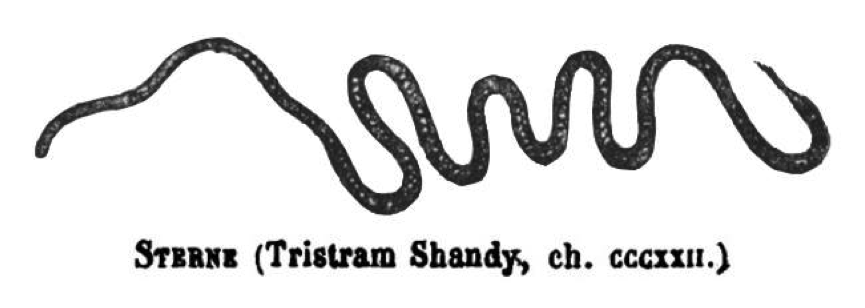
Indeed, the various transformations of Balzac’s squiggle, as of Sterne’s, are numerous and strange. Like the novel it adorns—an Oriental, fairy tale–like piece—this unlikeliest of figures has taunted generations of readers, publishers, and critics, daring them to parse it.
But there’s another, lesser-known chapter to this story: the intervention, between the British Sterne and the French Balzac, of the German E. T. A. Hoffmann. Hoffmann is remembered as the author of the original “Nutcracker” story—far more horrible than the version we might know from the ballet—and of the nightmarish “The Sandman,” which served as the foundation for Freud’s theory of the uncanny. This interim version of Sterne’s line, drawn by that master of the strange and the frightening, appears in “Fragment of a humoristic essay” dated at 1795 to 1800, some fifteen years before Hoffmann’s literary career took off in Berlin. The piece is short and strange, with a Jean-Paulesque introductory tableau featuring birds and lilies and stars interrupted by the line “Here, the Corporal Trim asked to insert his system of freedom, and it happens thus:”
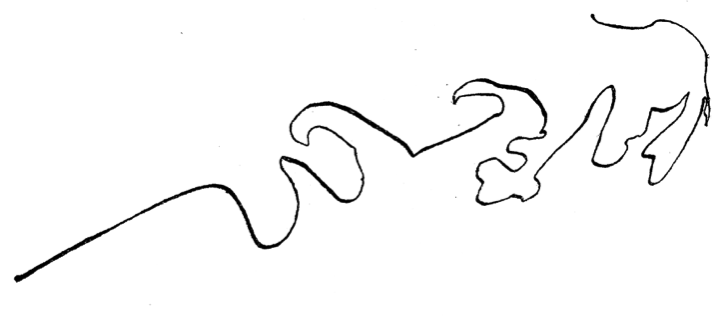
And “thus” emerges Hoffmann’s variation on Sterne’s story line, in a characteristically more fragmented picture, consisting less of curlicues and loops than of edges and what seem to be the outlines of faces. It’s one of Hoffmann’s earliest references to Sterne, whom he admired as the ultimate craftsman of literary form and whose narrative trickery he later assimilated in his own Kater Murr: a novel consisting of alternating manuscript fragments, half of them written by the musician Johannes Kreisler, the other half by a cat named Murr.
Hoffmann enjoyed a star-studded posthumous literary career in the Parisian literary journals in which Balzac also published his earliest works, and he inspired countless imitations, translations, and homages among the French literati of the 1830s. Balzac, for his part, denounced Hoffmann in various letters and articles. And yet he simultaneously peppered his own Human Comedy with numerous references to him: in the form of crazed German artists (“The Unknown Masterpiece”), Gothic revenants (“Colonel Chabert”), and a frame narrative describing its contents as “a frightening German story” told by “a young person who had read, without doubt, the tales of Hoffmann” (“The Red Inn”).
It seems all but impossible that Balzac could have come across this early fragment of Hoffmann’s. And this makes the episode all the more curious. It’s extraordinary to think these two writers—the one an eccentric Gothic Romantic, the other the father of European Realism—should both have independently arrived at the whimsical decision to copy out Sterne’s squiggle. The squiggle, in turn, becomes a wordless comment about lines of influence, shared inspirations, and the wayward directions taken by thought. When a review of The Magic Skin declared the novel to be an outright imitation of the kind of tale written by Hoffmann, Balzac denied the charge. But the novel itself, characterized by its intermingling of real and fantastic levels of narrative, might seem to contradict this. And the squiggle, as a strange double of Hoffmann’s, resembles another trace of this contradiction.
*In his early career, Balzac—like Sterne and Hoffmann had done before him—experimented with various typographic variables: the preface, the epithet, the dedication, and even his own name, which moved through a series of pseudonyms until he landed on the invented aristocratic “de” of Honoré de Balzac. His authorial identity, which he had also tried to define in a movement away from Hoffmannesque influence, is counterconstituted here by something out of his grasp: the trace of two authors’ independent readings of a third, taking the form of a squiggle, and the tendency of that squiggle to lead a life of its own.
It is irresistible to think of these three canonical authors—the British, the German, and then the French—each setting himself down to draw out his version of this superfluous thing, the word without letters or form without shape. Did they draw quickly or slowly? In several attempts or in a single stroke? It seems as unlikely that two people might share the same signature that two people might draw the same squiggle. In this way, the squiggle is a remnant of the embodied act of writing, of handwriting, the kind of writing that resists mass reproduction. As handwriting is slowly replaced by typing, and paper by the screen, these squiggles threaten to disappear. They’re lost in the move to the e-page or the kindle. In many modern editions of The Magic Skin, Balzac’s epigraph is absent. As for Corporal Trim’s flourish—for which Sterne paid, from his own pocket, for the original woodcut, so concerned was he to preserve his idiosyncratic typography—it is replaced, in the online Gutenberg version, by an ungainly note: “(squiggly line diagonally across the page).”
Squiggles thus present a challenge to the reproduction of text. And yet the bachelor’s squiggle is cast here as an unlikely father: one to have inspired a progeny taken up by hand, in imitation, imperfectly and improbably, in two separate countries. The squiggle persists, then, at the very limits of literary copy. Such a line is not just a replacement for text, for writing, but an emblem of reading: the figure for a three-way encounter between Sterne, Hoffmann, and Balzac. Their squiggles, then, aren’t conclusive so much as disruptive, excessive—a descriptive flourish at most; otherwise, a reminder that literary lines, like literary histories, do not always follow a predictable course.
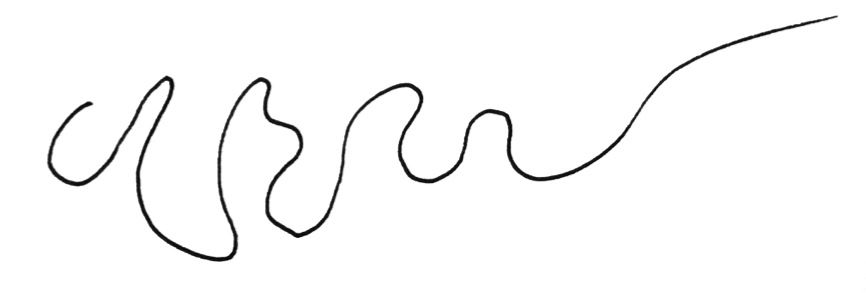
Polly Dickson is a Ph.D. candidate at the University of Cambridge, currently based in Berlin. She tweets at @pollyletitia.
Search
Categories
Latest Posts
Best Hydro Flask deal: Save $10 on a 24
2025-06-26 13:48LA Clippers vs. San Antonio Spurs 2025 livestream: Watch NBA online
2025-06-26 13:34Explore free romantic fantasy titles during Stuff Your Kindle Day
2025-06-26 12:39Chicago Bulls vs. Boston Celtics 2025 livestream: Watch NBA online
2025-06-26 12:18Alienware M16 Gaming Laptop deal: Save $560
2025-06-26 11:26Popular Posts
Best Sony deal: Save $100 on WH
2025-06-26 14:01Federal workers on Reddit resist Trump 'buyout' offer
2025-06-26 13:34Best monitor deal: Get the LG UltraGear gaming monitor for 47% off
2025-06-26 13:25What's new to streaming this week? (Jan. 31, 2025)
2025-06-26 13:12Boeing's new VR simulator immerses astronauts in space training
2025-06-26 11:25Featured Posts
Hidden Siri Commands and Unusual Responses
2025-06-26 13:57Stephen King's 'The Monkey' review on Threads is pretty unambiguous
2025-06-26 13:53NYT mini crossword answers for January 30, 2025
2025-06-26 13:05Sony PULSE Elite PS5 headset open
2025-06-26 12:48Popular Articles
Ryzen 5 1600X vs. 1600: Which should you buy?
2025-06-26 12:50Sri Lanka vs. Australia 2025 livestream: Watch 1st Test for free
2025-06-26 12:32UGREEN Nexode 25000mAh 200W power bank drops to $79.99 at Amazon
2025-06-26 11:23Newsletter
Subscribe to our newsletter for the latest updates.
Comments (445)
Wise Information Network
Best Garmin deal: Save over $100 on Garmin Forerunner 955
2025-06-26 13:07Happiness Information Network
Did Elon Musk push former FAA leader out? Trump admin responds after deadly plane crash
2025-06-26 12:53Transmission Information Network
Best Costco deal: Save $15 on delivery orders of $50 or more
2025-06-26 12:50Time Information Network
Minnesota Timberwolves vs. Phoenix Suns 2025 livestream: Watch NBA online
2025-06-26 11:36Impression Information Network
This is the fattest of the extremely fat bears
2025-06-26 11:27